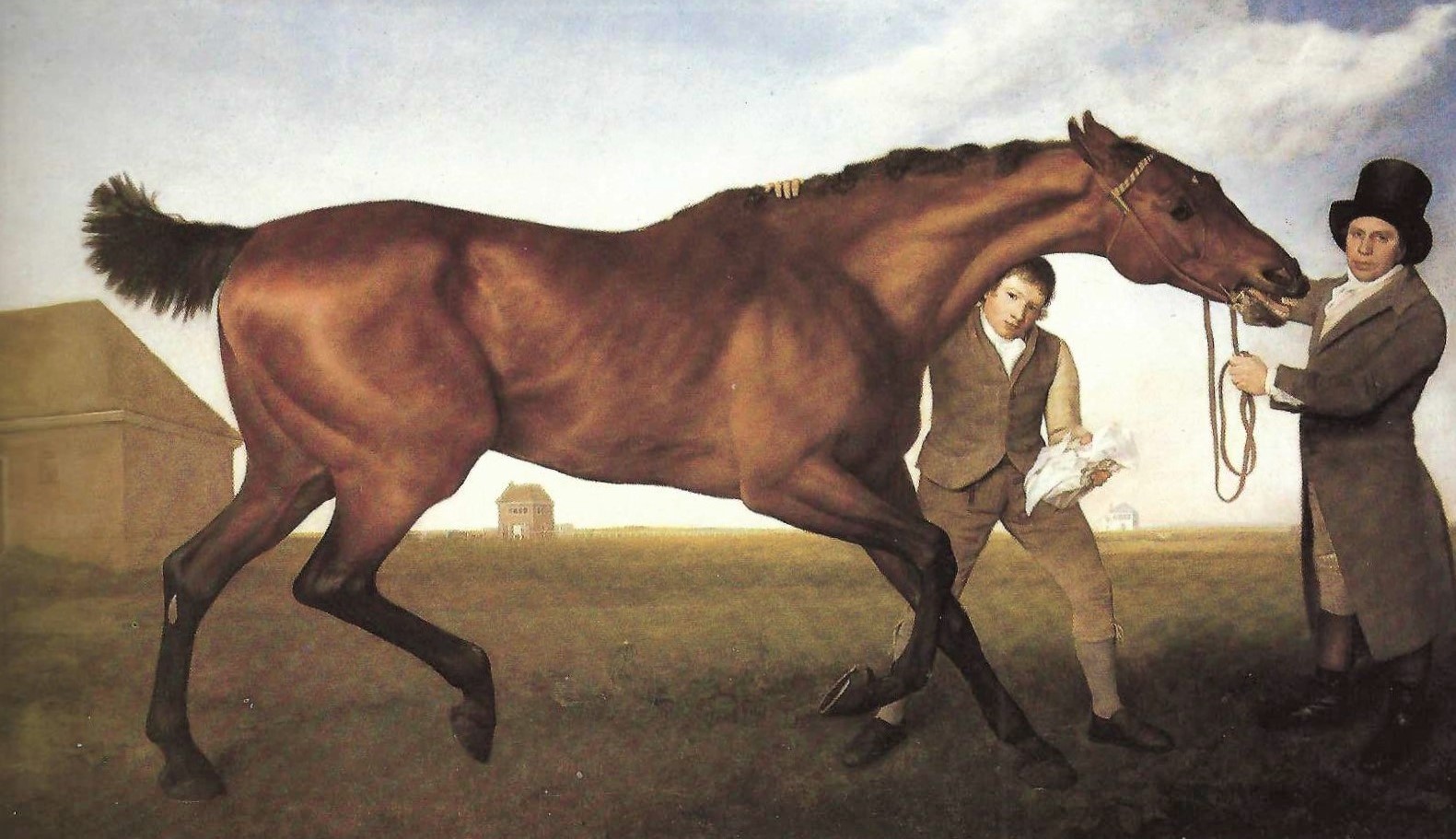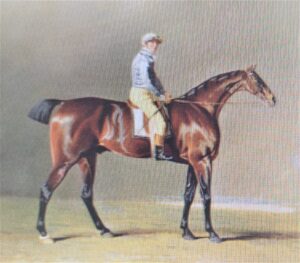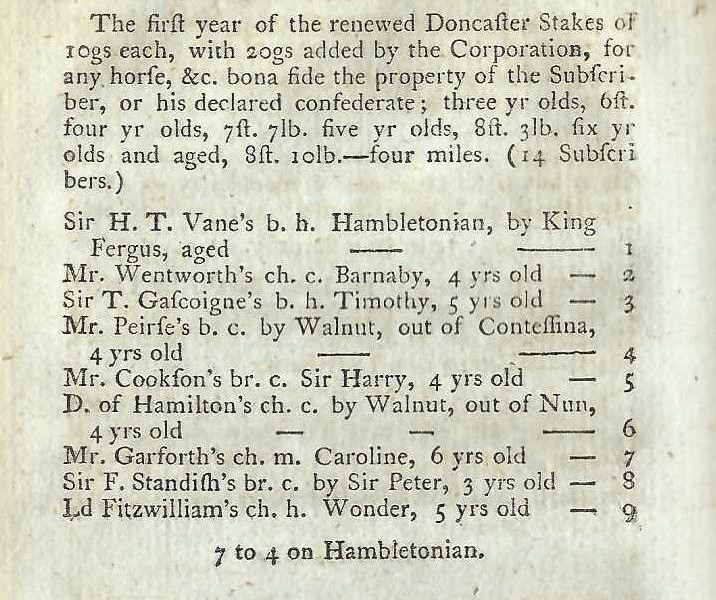HAMBLETONIAN
The Painting and the Horse

Whilst the George Stubbs painting of Hambletonian is widely recognised, the success story of this bay colt, born in 1792 is not.
Hambletonian was bred, owned and trained by John Hutchinson, the owner of a large estate in Shipley, near York. Early in his career, Hutchinson’s independent judgement paid off when he bought King Fergus, a son of Eclipse described as “A horse of great size and remarkably full of bone”, who after his successful racing career, had surprisingly shown very little at stud. However, when Hutchinson put King Fergus to the unnamed daughters of Herod and Highflyer, he got in two St Leger winners – Beningbrough in 1794 and Hambletonian in 1795.
After Hambletonian had won his first two races, Hutchinson decided to sell his three best horses with their entries to the young Yorkshire baronet Sir Charles Turner, for the great sum of 3,000 guineas. The bold young Turner soon made inroads into his outlay when Hambletonian won both the St Leger and Gold Cup on consecutive days at Doncaster.
Rested until August the following year, Hambletonian reappeared at York taking on the previous year’s Derby winner Spread Eagle. However, Hambletonian had thoughts of his own and soon after the start jumped over ropes and fled the course. Two days later, he re-opposed and beat Spread Eagle and the following day took the Ladies Plate, beating St George – both races over four miles.
Soon after, Hambletonian changed hands in romantic circumstances.
Sir Charles Turner had fallen in love with the daughter of a wealthy banker who would not give his consent to the marriage unless Sir Charles gave up the Turf and sold his horses. This he did, selling Benningbrough back to John Hutchinson and Hambletonian to Sir Harry Vane-Tempest.
Sir Harry, had while only receiving a small estate from his Reverend father, received a vast estate from his uncle John Tempest (whose only son had died in a riding accident), by hyphenating his name to Vane-Tempest.

With Hambletonian now heralded as the Champion of the North, Sir Harry threw down a challenge of a 3,000 guinea Match with a 800 guineas side bet, to Joseph Cookson’s colt Diamond (by Highflyer out of a Matchem mare), see aside, at that time the best horse at Newmarket. The race to be run at the Craven Meeting the following year, over the Beacon Course of 4 miles 1 furlong, 138 yards, Hambletonian to carry 8st. 3lbs and Diamond 8st. 0lb.
With so much public money resting on the match and Hambletonian absent from the racecourse for 18 months, Sir Harry turned again to John Hutchinson to assess his fitness. Hutchinson’s opinion that he could not win in his present state caused his trainer to resign leaving Hutchinson in charge of his preparation and the booking of Derby winning jockey, Frank Buckle to ride him. Meanwhile, Joseph Cookson arranged for Dennis Fitzpatrick to ride Diamond.
By now the match had caught the interest of the Nation and the date to be run March 25, Easter Monday, encouraging many thousands to travel down from the North. Sporting Magazine reported it “drew together the greatest concourse of people that ever was seen at Newmarket”, from where every bed was booked for 15 miles and beyond.
On the morning of the race betting on the match was estimated at around 25,000 guineas worth more than £2½ million today and although many private wagers were made at Evens, large professional bets were taken at 4-5 Hambletonian.
From the Off, Frank Buckle allowed Diamond to lead for a mile and a quarter, then slowly moved up to take about a half-length lead. Five furlongs from the finish Hambletonian’s lead had grown to two lengths, but Diamond showed his stamina to close, and the two ran neck and neck to the finish. Hambletonian, however, looking the most exhausted managed to make one last effort and got up in the very last stride to win by a head,

To show the toughness of Diamond, he came out again the next day and won a class of the Oatlands Stakes. Sadly, not so, Hambletonian, who having suffered much whipping and spurring, took six months rest before returning to win the Doncaster Stakes.

Soon after Hambletonian’s gruelling victory over Diamond, Vane-Tempest commissioned Stubbs to paint a picture of Hambletonian winning the race, hoping to profit from the sale of many engravings, with his colours in the forefront. However, when the Stubbs painting finally emerged, it was described as, “the image of a creature enduring the aftermath of a terrible, almost sacrificial triumph of which he was the hero”.
In consequence, Vane-Tempest refused to pay the 300 guineas demanded. Then after a high profile spirited debate in the Sheriffs court on 9 April 1801, Stubbs was given the full verdict.
On 28 August 1800, Hambletonian, aged eight, won the four-mile Great Subscription race at York, concluding a 19-race career with 18 victories. From there he retired to stud, firstly at Seacroft Hall near Leeds, at 10 guineas, then to the Hornsey stables in Middlethorpe and with further movements, finally to Catterick.
His notable produce included: Camillus gr.c. 1803, won Doncaster Cup and successful sire.
Goosander b.f. 1805, won 6 races. Dam of Shoveler b.f.1816 by Scud, won Oaks Stakes and Sailor ch. c. 1817 by Scud, won his only two races incl. Derby Stakes.
Camerton b.c. 1808, won Goodwood Cup. Sent to France in 1818.
Anticipation ch.c. 1812, won 16 races incl. Ascot Gold Cup (twice).
Finally, after siring nearly 150 winners, Hambletonian ended his days at Sir Harry Vane-Tempest’s former home Wynyard Park, in County Durham, where after his death on 28 March 1818, aged 26, he was buried under a huge oak tree.
Acknowledgement: The result of the Newmarket match and the Doncaster Stakes extracts are from Edward and Charles Weatherby’s Racing Calendar of 1799.
To see Michael’s interviews go to the foot of About Michael
For more racing history see Michael’s Books for Sale